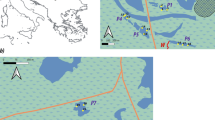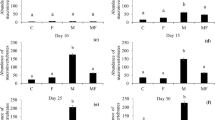Abstract
Headwater stream macroinvertebrates play an important role in processing allochthonous leaf litter, which suggests that bottom-up forces control macroinvertebrates. However, because larvae of stream-breeding salamanders are predators of macroinvertebrates and are abundant consumers in these ecosystems, macroinvertebrates in fishless headwater streams might also be controlled by top-down forces through predation by salamander larvae. The aim of this study was to test if and to what degree taxa richness, abundance, and biomass of macroinvertebrates are affected by bottom-up and top-down forces. We selected headwater streams with high abundances of fire salamander larvae (1.2–2.6 individuals per 1 m of shore length) and manipulated bottom-up and top-down forces on macroinvertebrates by leaf litter addition and by the exclusion of salamander larvae. The amphipod Gammarus fossarum Koch, 1836 was the dominant taxon and responded positively to litter addition. Linear models showed that neither predator exclusion nor leaf litter addition affected richness. However, variation in biomass and density were both explained by the individual and joint effects of bottom-up and top-down forces. These findings suggest that macroinvertebrates in these streams are strongly dependent on the organic matter input and salamander larvae, and headwater streams interact strongly with their adjacent terrestrial areas.


Similar content being viewed by others
References
Clarke, A., R. Mac Nally, N. Bond & P. S. Lake, 2008. Macroinvertebrate diversity in headwater streams: a review. Freshwater Biology 53: 1707–1721.
Clipp, H. L. & J. T. Anderson, 2014. Environmental and anthropogenic factors influencing salamanders in riparian forests: a review. Forests 5: 2679–2702.
Crawley, M. J., 2007. The R Book. Wiley, Chichester.
Cummins, K. W., 1973. Trophic relations of aquatic insects. Annual Review of Entomology 18: 183–206.
Cummins, K. W., 2002. Riparian-stream linkage paradigm. Internationale Vereinigung fur Theoretische und Angewandte Limnologie Verhandlungen 28(1): 49–58.
Dahl, J., 1998. Effects of a benthivorous and a drift-feeding fish on a benthic stream assemblage. Oecologia 116: 426–432.
Davic, R. D. & H. H. Welsh, 2004. On the ecological role of salamanders. Annual Review of Ecology, Evolution and Systematics 35: 405–434.
Dobson, M. & A. G. Hildrew, 1992. A test of resource limitation among shredding detritivores in low order streams in southern England. Journal of Animal Ecology 61: 69–77.
Dobson, M., A. G. Hildrew, A. Ibbotson & J. Garthwaite, 1992. Enhancing litter retention in streams: do altered hydraulics and habitat area confound field experiments? Freshwater Biology 28: 71–79.
Duferne, M. & P. Legendre, 1997. Species assemblages and indicator species: the need for a flexible asymmetrical approach. Ecological Monographs 67: 345–366.
Flory, E. & A. M. Milner, 1999. Influence of riparian vegetation on invertebrate assemblages in a recent formed stream in Glacier Bay National park, Alaska. Journal of the North American Benthological Society 18: 261–273.
Gessner, M. O. & E. Chauvet, 2002. A case for using litter breakdown to assess functional stream integrity. Ecological Applications 12: 498–510.
Gessner, M. O., E. Chauvet & M. Dobson, 1999. A perspective on leaf litter breakdown in streams. Oikos 85: 377–384.
Heino, J., T. Muotka & R. Pavola, 2003. Determinants of macroinvertebrate diversity in headwater streams: regional and local influences. Journal of Animal Ecology 72: 425–434.
Heino, J., J. Parviarien, P. Paavola, M. Jehle, P. Louchi & T. Muotka, 2005. Characterizing macroinvertebrate assemblage structure in relation to stream site and tributary position. Hydrobiologia 539: 121–130.
Huang, C. & A. Sih, 1991. An experimental-study on the effects of salamander larvae on isopods in stream pools. Freshwater Biology 25: 451–459.
Jabiol, J., J. Cornut, M. Danger, M. Jouffroy, A. Elger & E. Chauvet, 2014. Litter identity mediates predator impacts on the functioning of an aquatic detritus-based food web. Oecologia 176: 225–235.
Johnson, B. R. & J. B. Wallace, 2005. Bottom-up limitation of a stream salamander in a detritus-based food web. Canadian Journal of Fisheries and Aquatic Sciences 62: 301–311.
Keitzer, S. C. & R. R. Goforth, 2013. Salamander diversity alters stream macroinvertebrate community structure. Freshwater Biology 58: 2114–2125.
Koetsier, P., 2002. Short-term benthic colonization dynamics in an agricultural stream recovering from slaughterhouse effluents. Journal of the American Water Resources Association 38: 1–14.
Lechthaler, W., 2009. Macrozoobenthos key to families of macroinvertebrates in European freshwaters. Eutaxa taxonomic software for biological scientists. DVD Edition, Vienna.
Liboriussen, L., E. Jeppesen, M. E. Bramm & M. F. Lassen, 2005. Periphyton-macroinvertebrate interactions in light and fish manipulated enclosures in a clear and a turbid shallow lake. Aquatic Ecology 39: 23–39.
Meijering, M. P. D., 1972. Physiologische Beitrage zur Frage der systematischen Stellung von Gammarus pulex (L.) and Gammarus fossarum Koch (Amphipoda). Crustaceana 3: 313–325.
Meissner, K. & T. Muotka, 2006. The role of trout in stream food webs: integrating evidence from field surveys and experiments. Journal of Animal Ecology 75: 421–433.
MeteoSwiss, 2013. Climate normals. Visp, reference period 1981–2010. Available at: http://www.meteoswiss.ch. Assessed Oct 2013).
Mouilot, D., J. M. Culioli, D. Pelletier & J. A. Tomasini, 2008. Do we protect biological originality in protected areas? A new index and an application to the Bonifacio Strait Natural Reserve. Biological Conservation 141: 1569–1580.
Murphy, J. F., P. S. Giller & M. A. Horan, 1998. Spatial scale and the aggregation of stream macroinvertebrates associated with leaf packs. Freshwater Biology 39: 325–337.
Olson, D. H., J. B. Leirness, P. G. Cunningham & E. A. Steel, 2014. Riparian buffers and forest thinning: effects on headwater vertebrates 10 years after thinning. Forest Ecology and Management 321: 81–94.
Power, M. E., 1992. Top-down and bottom-up forces in food webs: do plants have primacy. Ecology 73: 733–746.
R Core team, 2013. R: a language and environment for statistical computing. R Foundation for Statistical Computin, Vienna. http://www-R-project.org/.
Reinhardt, T., S. Steinfartz, A. Paetzold & M. Weitere, 2013. Linking the evolution of habitat choice to ecosystem functioning: direct and indirect effects of pond-reproducing fire salamanders on aquatic-terrestrial subsidies. Oecologia 173: 281–291.
Richardson, J. S., 1992. Food, microhabitat, or both? Macroinvertebrate use of leaf accumulations in a montane stream. Freshwater Biology 27: 169–176.
Richardson, J. S. & R. J. Danehy, 2007. A synthesis of the ecology of headwater streams and their riparian zones in temperate forests. Forest Science 53: 131–147.
Ruff, H. & G. Maier, 2000. Calcium carbonate deposits reduce predation pressure on Gammarus fossarum from salamander larvae. Freshwater Biology 43: 99–105.
Schmera, D., 2004. Spatial distribution and coexistence patterns of caddisfly larvae (Trichoptera) in a Hungarian stream. International Review of Hydrobiology 89: 51–57.
Schmera, D. & T. Erős, 2004. Effect of riverbed morphology, stream order and season on the structural and functional attributes of caddisfly assemblages (Insecta: Trichoptera). Annales de Limnologie – International Journal of Linology 40: 193–200.
Schmera, D., B. Baur & T. Erős, 2012. Does functional redundancy of communities provide insurance against human disturbance? An analysis using regional-scale stream invertebrate data. Hydrobiologia 693: 183–194.
Sircom, J. & S. J. Walde, 2009. Disturbance, fish, and variation in the predatory insect guild of costal streams. Hydrobiologia 620: 181–190.
Tachet, H., P. Richoux, M. Bournaud & P. Usseglio-Polatera, 2010. Invertébrés d’eau douce: systématique, biologie, écologie. CNRS Editions, Paris: 588.
Thiesmeier, B., 1982. Beitrag zur Nahrungsbiologie der Larven des Feuersalamanders, Salamandra salamandra (L.) (Amphibia: Caudata: Salamandridae). Salamandra 18: 86–88.
Thiesmeier, B., 2004. Der Feuersalmamander. Laurenti Verlag, Bielefeld: 192.
Townsend, C. R. & A. G. Hildrew, 1976. Field experiments on the drifting, colonization and continuous redistribution of stream benthos. Journal of Animal Ecology 45: 759–772.
Wallace, J. B., S. L. Eggert, J. L. Meyer & J. R. Webster, 1997. Multiple tropic levels of a forest stream linked to terrestrial litter inputs. Science 277: 102–104.
Weigelhofer, G. & J. Waringer, 2003. Vertical distribution of benthic macroinvertebrates in riffles versus deep runs with differing contents of fine sediments (Weidlingbach, Austria). International Review of Hydrobiology 88: 304–313.
Williams, L. R., C. M. Taylor & M. L. Warren Jr, 2003. Influence of fish predation on assemblage structure of macroinvertebrates in an intermittent stream. Transactions of the American Fisheries Society 132: 120–130.
Wirth, A., D. Schmera & B. Baur, 2010. Native and alien macroinvertebrate richness in a remnant of the former river Rhine: a source for recolonisation of restored habitats? Hydrobiologia 652: 89–100.
Wolfgang, E., 1989. Was lebt in Tümpel, Bach und Weiher? Kosmos Naturführer. Franckh-Kosmos, Stuttgart: 313.
Zeug, Z. S., L. K. Albertson, J. Hardy & B. Cardinale, 2011. Predictors of Chinook salmon extirpation in California’s Central Valley. Fisheries Management and Ecology 18: 61–71.
Acknowledgments
We thank Dr. Benedikt Schmidt (University of Zurich) for providing information about the distribution salamander larvae, Peter Tanner (Abteilung Natur und Landschaft, Kanton Baselland, Schweiz) for permitting the collection of macroinvertebrates in the studied streams, and Prof. Dr. Lee Kats and four anonymous reviewers for their comments on the manuscript. We thank Dr. Krystyna Haq and Dr. Jo Edmondston for checking the English in the manuscript.
Author information
Authors and Affiliations
Corresponding author
Additional information
Handling editor: Lee B. Kats
Rights and permissions
About this article
Cite this article
Nery, T., Schmera, D. The effects of top-down and bottom-up controls on macroinvertebrate assemblages in headwater streams. Hydrobiologia 763, 173–181 (2016). https://doi.org/10.1007/s10750-015-2371-5
Received:
Revised:
Accepted:
Published:
Issue Date:
DOI: https://doi.org/10.1007/s10750-015-2371-5




